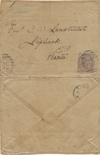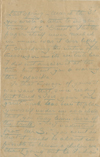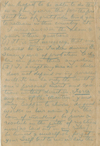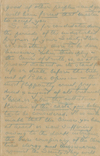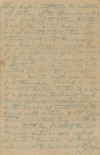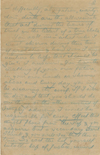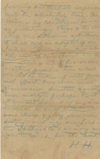Mahatma Letter to Leadbeater - LMW 1 No. 7
| Quick Facts | |
|---|---|
| People involved | |
| Written by: | Koot Hoomi |
| Received by: | Charles Webster Leadbeater |
| Sent via: | post |
| Dates | |
| Written on: | unknown |
| Received on: | 31 October 1884, at midday |
| Other dates: | unknown |
| Places | |
| Sent from: | Kensington post office |
| Received at: | London |
| Via: | unknown |
This letter is Letter No. 7 in Letters from the Masters of the Wisdom, First Series. Mahatma Koot Hoomi responds to questions from Charles Webster Leadbeater about chelaship. It is closely related to the following letter, No. 8.[1]
< Prev letter in LMW 1
Next letter in LMW 1 >
Envelope
|
The Revd. C. W. Leadbeater |
NOTES: |
Page 1 transcription, image, and notes
|
Last spring – March the 3rd – you wrote a letter to me and entrusted it to “Ernest”. Tho' the paper itself never reached me – nor was it ever likely to, considering the nature of the messenger – its contents have. I did not answer it at the time, but sent you a warning through Upasika. In that message of yours it was said that, since reading Esot. Bud. and Isis your “one great wish" had been to place yourself under me as a chela, that you may learn more of the truth. “I understand from Mr. S.” you went on “that it would be almost impossible to become a chela without going out to India”. |
NOTES:
|
Page 2
|
You hoped to be able to do that in a few years, tho' for the present ties of gratitude bind you to remain in this country, etc. I now answer the above and your other questions. 1. It is not necessary that one should be in India during the seven years of probation. A chela can pass them anywhere. 2. To accept any man as a chela does not depend on my personal will. It can only be the result of one's personal merit and exertions in that direction. Force any one of the “Masters” you may happen to choose; do good works in his name and for the love of mankind; be pure and resolute in the path of righteousness (as laid out in our rules); be honest and unselfish; forget your Self but to remember the |
NOTES: |
Page 3
|
good of other people – and you will have forced that “Master” to accept you. So much for candidates during the periods of the undisturbed progress of your Society. There is something more to be done, however, when theosophy, the Cause of Truth, is, as at the present moment on its stand for life or death before the tribunal of public opinion – that most flippantly cruel, prejudiced and unjust of all tribunals. There is also the collective karma of the caste you belong to – to be considered. It is undeniable that the cause you have at heart is now suffering owing to the dark intrigues, the base conspiracy of the Christian clergy and missionaries against the Society. They will |
NOTES: |
Page 4
|
stop before nothing to ruin the reputation of the Founders. Are you willing to atone for their sins? Then go to Adyar for a few months. “The ties or gratitude” will not be severed, nor even become weakened for an absence of a few months if the step be explained plausibly to your relative. He who would shorten the years of probation has to make sacrifices for theosophy. Pushed by malevolent hands to the very edge of a precipice, the Society needs every man and woman strong in the cause of truth. It is by doing noble actions and not by only determining that they shall be done that the fruits of the meritorious actions are reaped. Like the “true man” of Carlyle who is not to be seduced by ease |
NOTES:
|
Page 5
|
– “difficulty, abnegation, martyrdom, death are the allurements that act” during the hours of trial on the heart of a true chela. You ask me – “what rules I must observe during this time of probation, and how soon I might venture to hope that it could begin”. I answer: you have the making of your own future, in your own hands as shown above, and every day you may be weaving its woof. If I were to demand that you should do one thing or the other, instead of simply advising, I would be responsible for every effect that might flow from the step and you acquire but a secondary merit. Think, and you will see that this is true. So cast the lot yourself into the lap of Justice, never |
NOTES: |
Page 6
|
fearing but that its response will be absolutely true. Chelaship is an educational as well as probationary stage and the chela alone can determine whether it shall end in adeptship or failure. Chelas from a mistaken idea of our system too often watch and wait for orders, wasting precious time which should be taken up with personal effort. Our cause needs missionaries, devotees, agents, even martyrs perhaps. But it cannot demand of any man to make himself either. So now choose and grasp your own destiny, and may our Lord’s the Tathgata’s memory aid you to decide for the best.
|
NOTES:
|
Context and background
Mr. Jinarajadasa provided these notes about this letter:
Transcribed from the original at Adyar. This and the following letter were received by C.W. Leadbeater, the former at midday of the 31 October 1884, and the latter at midnight of the same day. The first letter was received by post, and bears the London postmark, ‘Kensington, Oct. 30-84’; the second letter was precipitated on to the upturned palm of H.P.B. in the presence of C.W.L. I have reproduced in facsimile this letter and Letter 8 in my book, The K.H. Letters to C.W. Leadbeater.
At this time C.W.L was closely investigating Spiritualism, and was attending many of the séances of William Eglinton, one of whose spirit guides was named ‘Ernest’. Ernest assured C.W.L. that he knew of the existence of the Masters, and intimated his readiness to deliver a letter to the Master K.H. The letter was written and sent, and put by Mr Eglinton in the box kept for communications for the spirit guides. C.W.L. was notified by Mr Eglinton after a few days that the letter had disappeared from the box. At subsequent séances, when enquiry was made from Ernest as to what had happened to the letter, Ernest assured C.W.L. that it had been duly delivered.
Upasika is a more often used for H.P.B. in the letters; the word is from Buddhism, where it denotes a woman lay disciple, one who has taken the eight vows, and so is not a nun who takes two more vows in addition.
‘Caste you belong to’: C.W.L. at the time of receiving this letter was an officiating priest of the Church of England; it was at this time that an attempt was made by the Christian missionaries at Madras to wreck the Theosophical Society in what is known as the ‘Coulomb conspiracy’.
‘Our Lord’s the Tathgata’s memory’: This is a most striking phrase, understood only many long years after the receipt of the letter. It refers to incidents of past lives of long ago, when C.W.L. had seen the great Teacher face to face. It is as if the Master tried in this manner to go behind the personality of C.W.L. direct to the Ego, in whose consciousness the great truths existed as matters of direct knowledge.
Several phrases in this letter, and especially the phrase ‘Our Lord’s the Tathgata’s memory aid you to decide for the best’, appear in a letter written by the Master M., who did not know English, to S. Ramaswamier, in 1883. (See Letters from the Masters of the Wisdom, Second Series, Letter 51.)[3]
For the circumstances surrounding the receipt of this letter, you can read C. W. Leadbeater's own account here.
Physical description of letter
According to Mr. Jinarajadasa, the original letter is at the Adyar headquarters of the Theosophical Society.
Publication history
Initially this letter was printed (with the Master's permission) in the January, 1908 issue of The Theosophist after C. Jinarajadasa copied it from the original during a visit to Taormina, as mentioned above.[4]
This letter was published in 1919 as Letter 7 in the first edition of Letters from the Masters of the Wisdom, 1881-1888, later known as the First Series.[5] It has kept this designation as Letter 7 throughout all editions.
Commentary about this letter
C. Jinarājadāsa devoted an entire book, The "K. H." Letters to C. W. Leadbeater, to an intensive analysis of the three letters received by C. W. Leadbeater. At the beginning of the commentary for the first letter he wrote:
As this letter of the Master is full of illumination to students of Occultism, I propose, after the manner of the commentators of old of the Vedas and the Upanishads, to comment on all phrases in it which require elucidation, in order to bring out the full significance of the Master's thought.[6]
This first letter in particular provides a wealth of historical and occult information. Some details are provided in the Notes above. Here are some other major points:
- CWL felt the weight of major responsibilities as a curate in managing the routine work of the parish, since the Rector (his uncle) was often away at Oxford teaching. He was grateful to his uncle and regretted causing difficulties by departing for India.[7]
- The Mahatmas knew what was happening in his life even though they were physically far away.[8]
- The would-be chela sets occult forces in motion by asking to become a disciple, and can "force" the Master to accept him.[9]
- The Masters never used the term "Masters" but instead referred to themselves as "Brothers."[10]
- For someone of CWL's clerical background, Master K.H. found it appropriate to recommend a path to Liberation that was based on the love of God in combination with charity to fellow humans.[11]
- Finding a guru or Master is not a matter of travel, but "an inner change of heart and mind."[12]
- Religious creeds and rules of conduct are ephemeral; the Adept is concerned instead with "the fundamental realities which underlie right thought, feeling and action."[13]
- The Coulomb affair was a betrayal of Madame Blavatsky by Emma Coulomb and her husband, but more importantly an attack by Christian missionaries upon humanity. The Masters foresaw the attack and subtly warned about it, but could not change events, but had to let karma unfold.[14]
- Madame Blavatsky, Annie Besant, and C. W. Leadbeater all steadfastly continued their Theosophical work, despite public persecution.[15]
- Leadbeater, as an ordained Christian priest, helped to atone for the collective karma of the "caste" (Christians) by going to Madras to work for the Theosophical Society.[16]
- Sacrifices are necessary on the spiritual path.[17]
- The word Theosophy is rarely used by the Masters, and is in lower case. "Every member of the Society can claim the right, under the Constitution, to declare what Theosophy is, or what it is not."[18]
- Doing and deeds are emphasized – not dreaming or hoping.[19]
- K.H. quotes from Thomas Carlyle's book Heroes and Hero Worship. However, Carlyle's use of the term God is rejected as referring to a Personal God rather than the Ultimate Reality.[20]
- Would-be chelas are rigorously tested, and few succeed. The Indian system of Guru and Shishya (pupil), where the pupil is a dependent server, is not the model for the relationship of the Master and his chela. The chela takes responsibility for his own actions.[21]
- CWL had an actual memory from a past life of the Tathâgata (Gautama Buddha) and must be guided by that memory.[22]
Additional resources
Notes
- ↑ C. Jinarajadasa, Letters from the Masters of the Wisdom, First Series (Adyar, Chennai, India: Theosophical Publishing House, 2011), 29-32, 141-143.
- ↑ Bryce R. Covert, "Masculinity in Thomas Carlyle's On Heroes, Hero-Worship and the Heroic in History" in The Victorian Web.
- ↑ C. Jinarajadasa, 141-143.
- ↑ "Echoes from the Past" The Theosophist 29.4 (January, 1908), 357-358.
- ↑ Letters from the Masters of the Wisdom, 1881-1888. Adyar, Madras, India; London: Theosophical Publishing House, 1919. Foreword by Annie Besant; transcribed and compiled by C. Jinarajadasa.
- ↑ C. Jinarājadāsa, The "K. H." Letters to C. W. Leadbeater (Adyar, Madras, India: Theosophical Publishing House, 1941), 15.
- ↑ Jinarājadāsa, 16-17, 31.
- ↑ Jinarājadāsa, 16, 17-19.
- ↑ Jinarājadāsa, 19-20.
- ↑ Jinarājadāsa, 21.
- ↑ Jinarājadāsa, 22-23.
- ↑ Jinarājadāsa, 22-23.
- ↑ Jinarājadāsa, 24.
- ↑ Jinarājadāsa, 25-29.
- ↑ Jinarājadāsa, 29-30.
- ↑ Jinarājadāsa, 30-31.
- ↑ Jinarājadāsa, 32-34.
- ↑ Jinarājadāsa, 34-35.
- ↑ Jinarājadāsa, 35.
- ↑ Jinarājadāsa, 35-40.
- ↑ Jinarājadāsa, 40-44.
- ↑ Jinarājadāsa, 45-46.
